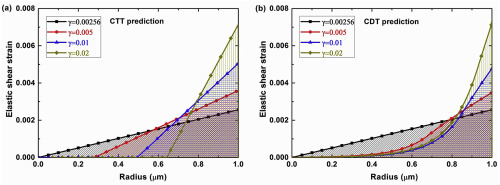当前位置:
X-MOL 学术
›
Acta Mater.
›
论文详情
Our official English website, www.x-mol.net, welcomes your
feedback! (Note: you will need to create a separate account there.)
Critical thickness phenomenon in single-crystalline wires under torsion
Acta Materialia ( IF 8.3 ) Pub Date : 2018-05-01 , DOI: 10.1016/j.actamat.2018.03.022 Dabiao Liu , Xu Zhang , Yuan Li , D.J. Dunstan
Acta Materialia ( IF 8.3 ) Pub Date : 2018-05-01 , DOI: 10.1016/j.actamat.2018.03.022 Dabiao Liu , Xu Zhang , Yuan Li , D.J. Dunstan

|
Abstract Analysis of idealised thin single-crystal wires under torsion based on the continuum theory of dislocations gives results in accordance with the critical thickness theory. The dislocation-free zone near the wire surface and the nearly-zero stress around the wire axis are predicted by both the continuum dislocation theory and critical thickness theory. It is demonstrated that the size effect at the onset of yielding, the distributions of stress and geometrically necessary dislocations in the thin wires in torsion, simply result from the critical thickness effect. A continuous increase of plastic strain from the neutral axis toward the wire surface is indicated. The plastic strain becomes (nearly) flat around the wire surface. Such a phenomenon is attributed to the fact that this is the region in which dislocations sources can operate, to provide the geometrically necessary dislocations required by the plastic strain gradient beneath. The results of continuum dislocation theory quantitatively elucidate the critical thickness phenomenon occurred in single-crystal wires under torsion. This links the continuum dislocation theory to the underlying physical picture of Matthews' critical thickness theory.
中文翻译:

单晶线受扭临界厚度现象
摘要 基于位错连续谱理论对理想化单晶细线扭转进行分析,得到符合临界厚度理论的结果。连续位错理论和临界厚度理论都预测线表面附近的无位错区和线轴周围的应力几乎为零。结果表明,屈服开始时的尺寸效应、应力分布和扭转细线中的几何必要位错,只是临界厚度效应的结果。表明从中性轴到导线表面的塑性应变连续增加。塑性应变在电线表面周围变得(几乎)平坦。这种现象归因于这样一个事实,即这是位错源可以运行的区域,提供下方塑性应变梯度所需的几何必要位错。连续位错理论的结果定量地阐明了扭转作用下单晶线中发生的临界厚度现象。这将连续位错理论与马修斯临界厚度理论的基本物理图景联系起来。
更新日期:2018-05-01
中文翻译:

单晶线受扭临界厚度现象
摘要 基于位错连续谱理论对理想化单晶细线扭转进行分析,得到符合临界厚度理论的结果。连续位错理论和临界厚度理论都预测线表面附近的无位错区和线轴周围的应力几乎为零。结果表明,屈服开始时的尺寸效应、应力分布和扭转细线中的几何必要位错,只是临界厚度效应的结果。表明从中性轴到导线表面的塑性应变连续增加。塑性应变在电线表面周围变得(几乎)平坦。这种现象归因于这样一个事实,即这是位错源可以运行的区域,提供下方塑性应变梯度所需的几何必要位错。连续位错理论的结果定量地阐明了扭转作用下单晶线中发生的临界厚度现象。这将连续位错理论与马修斯临界厚度理论的基本物理图景联系起来。











































 京公网安备 11010802027423号
京公网安备 11010802027423号